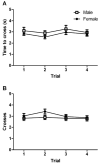The influence of non-nociceptive factors on hot-plate latency in rats
- PMID: 20797920
- PMCID: PMC3312470
- DOI: 10.1016/j.jpain.2010.06.011
The influence of non-nociceptive factors on hot-plate latency in rats
Abstract
The hot plate is a widely used test to assess nociception. The effect of non-nociceptive factors (weight, sex, activity, habituation, and repeated testing) on hot-plate latency was examined. Comparison of body weight and hot-plate latency revealed a small but significant inverse correlation (light rats had longer latencies). Habituating rats to the test room for 1 hour prior to testing did not decrease hot-plate latency except for female rats tested on days 2 to 4. Hot-plate latency decreased with repeated daily testing, but this was not caused by a decrease in locomotor activity or learning to respond. Activity on the hot plate was consistent across all 4 trials, and prior exposure to a room-temperature plate caused a similar decrease in latency as rats tested repeatedly on the hot plate. Despite this decrease in baseline hot-plate latency, there was no difference in morphine antinociceptive potency. The present study shows that weight, habituation to the test room, and repeated testing can alter baseline hot-plate latency, but these effects are small and have relatively little impact on morphine antinociception.
Perspective: This manuscript shows that non-nociceptive factors such as body weight, habituation, and repeated testing can alter hot-plate latency, but these factors do not alter morphine potency. In sum, the hot-plate test is an easy to use and reliable method to assess supraspinally organized nociceptive responses.
Copyright © 2011 American Pain Society. Published by Elsevier Inc. All rights reserved.
Figures





Comment in
-
Should the hot-plate test be reincarnated?J Pain. 2011 Aug;12(8):936-7; author reply 938-9. doi: 10.1016/j.jpain.2011.05.003. J Pain. 2011. PMID: 21816354 No abstract available.
References
-
- Ankier SI. New hot plate tests to quantify antinociceptive and narcotic antagonist activities. Eur J Pharmacol. 1974;27:1–4. - PubMed
-
- Bannon AW, Malmberg AB. Models of nociception: hot-plate, tail-flick, and formalin tests in rodents. Curr Protoc Neurosci. 2007;Chapter 8: Unit 8 9 - PubMed
-
- Bardo MT, Hughes RA. Exposure to a nonfunctional hot plate as a factor in the assessment of morphine-induced analgesia and analgesic tolerance in rats. Pharmacol Biochem Behav. 1979;10:481–5. - PubMed
-
- Chesler EJ, Wilson SG, Lariviere WR, Rodriguez-Zas SL, Mogil JS. Identification and ranking of genetic and laboratory environment factors influencing a behavioral trait, thermal nociception, via computational analysis of a large data archive. Neurosci Biobehav Rev. 2002;26:907–23. - PubMed
Publication types
MeSH terms
Grants and funding
LinkOut - more resources
Full Text Sources
Medical

